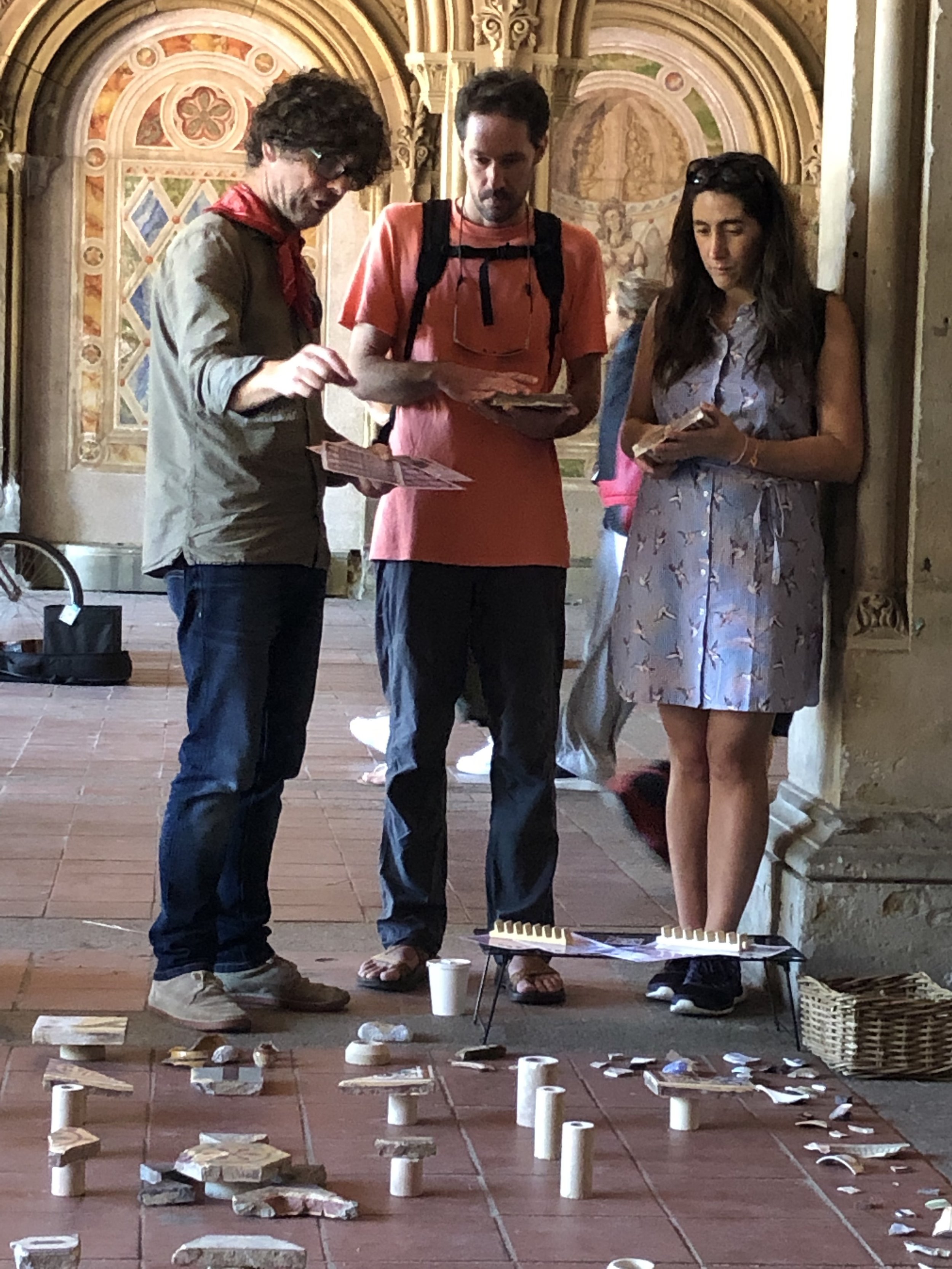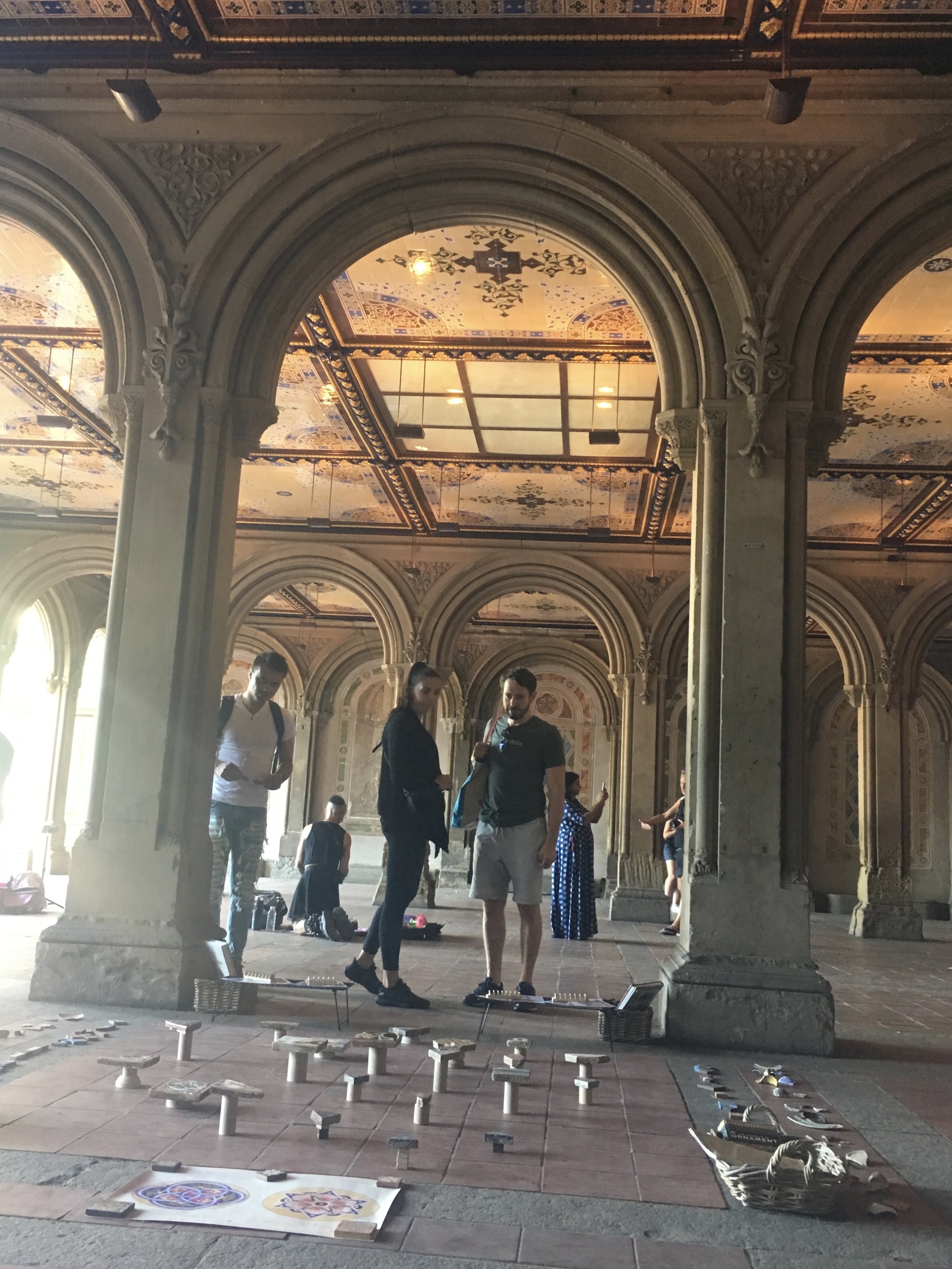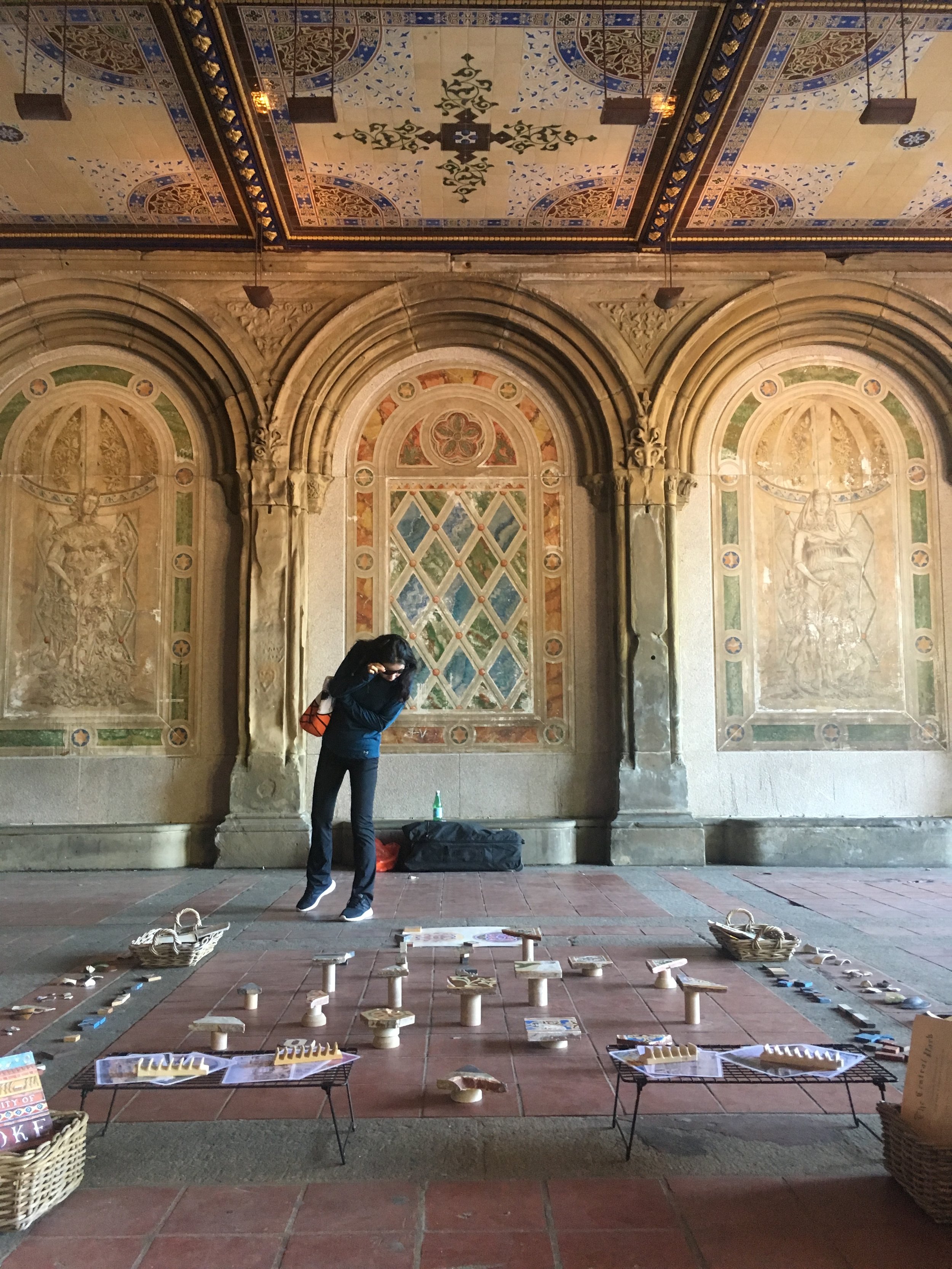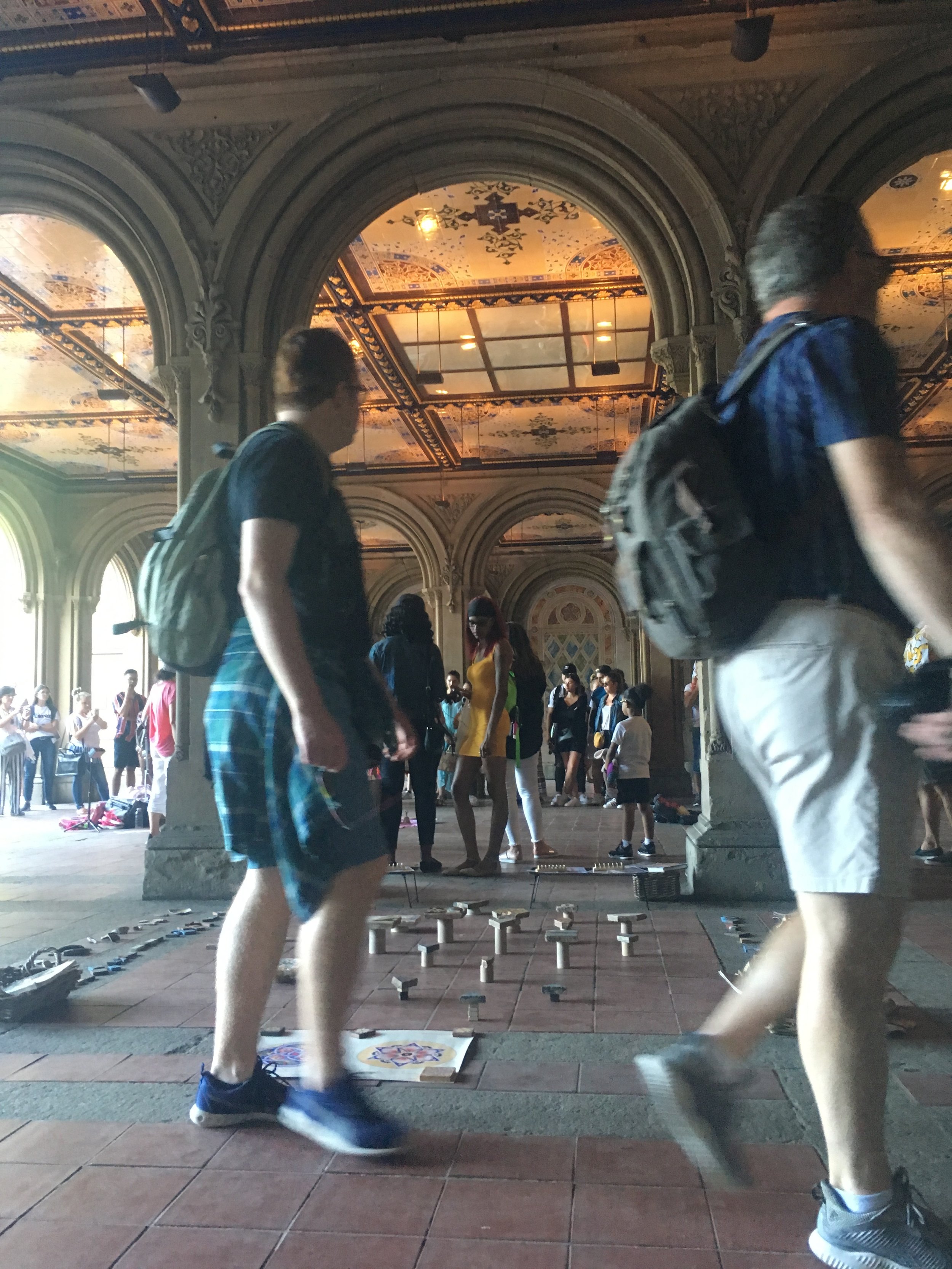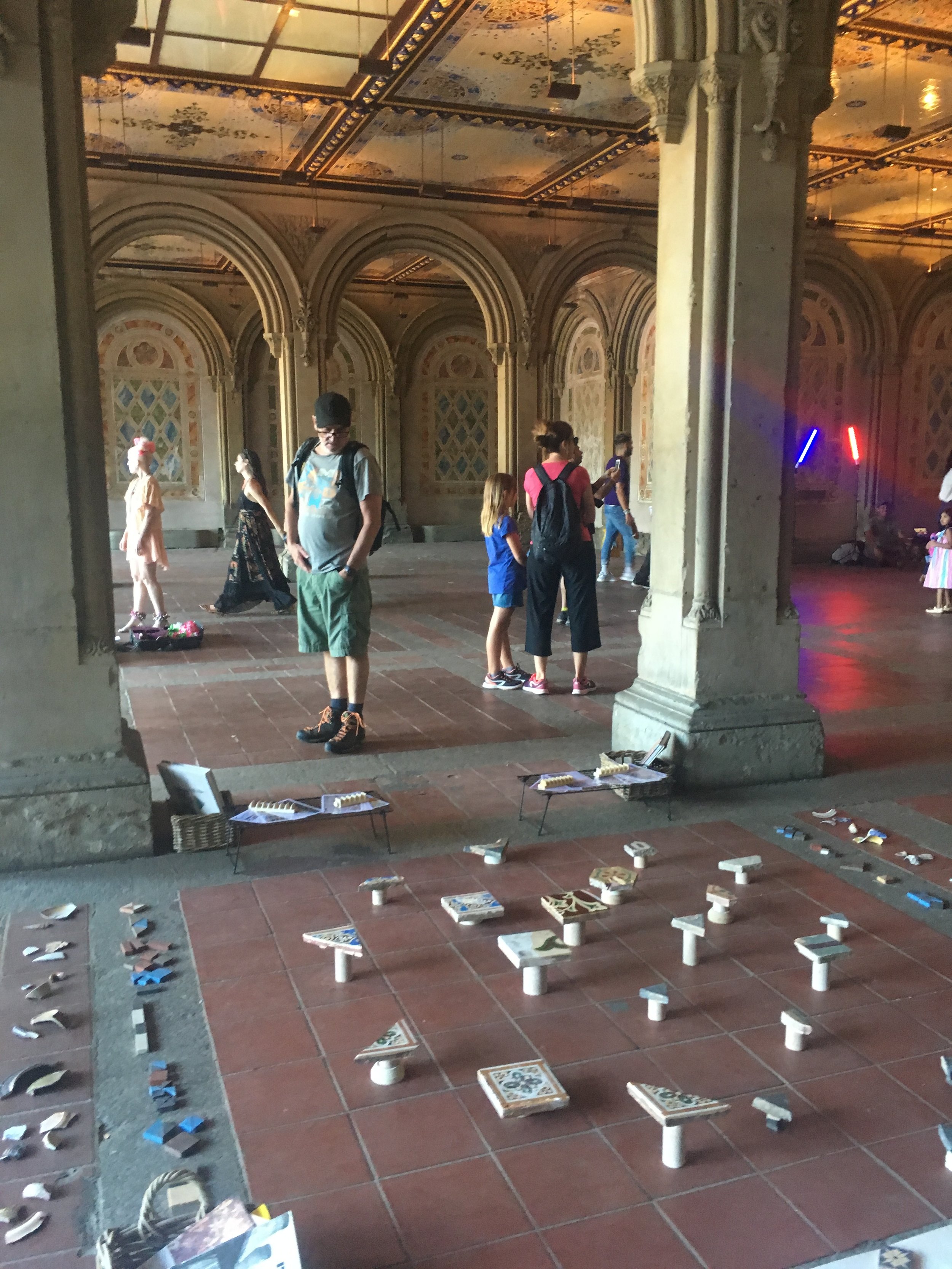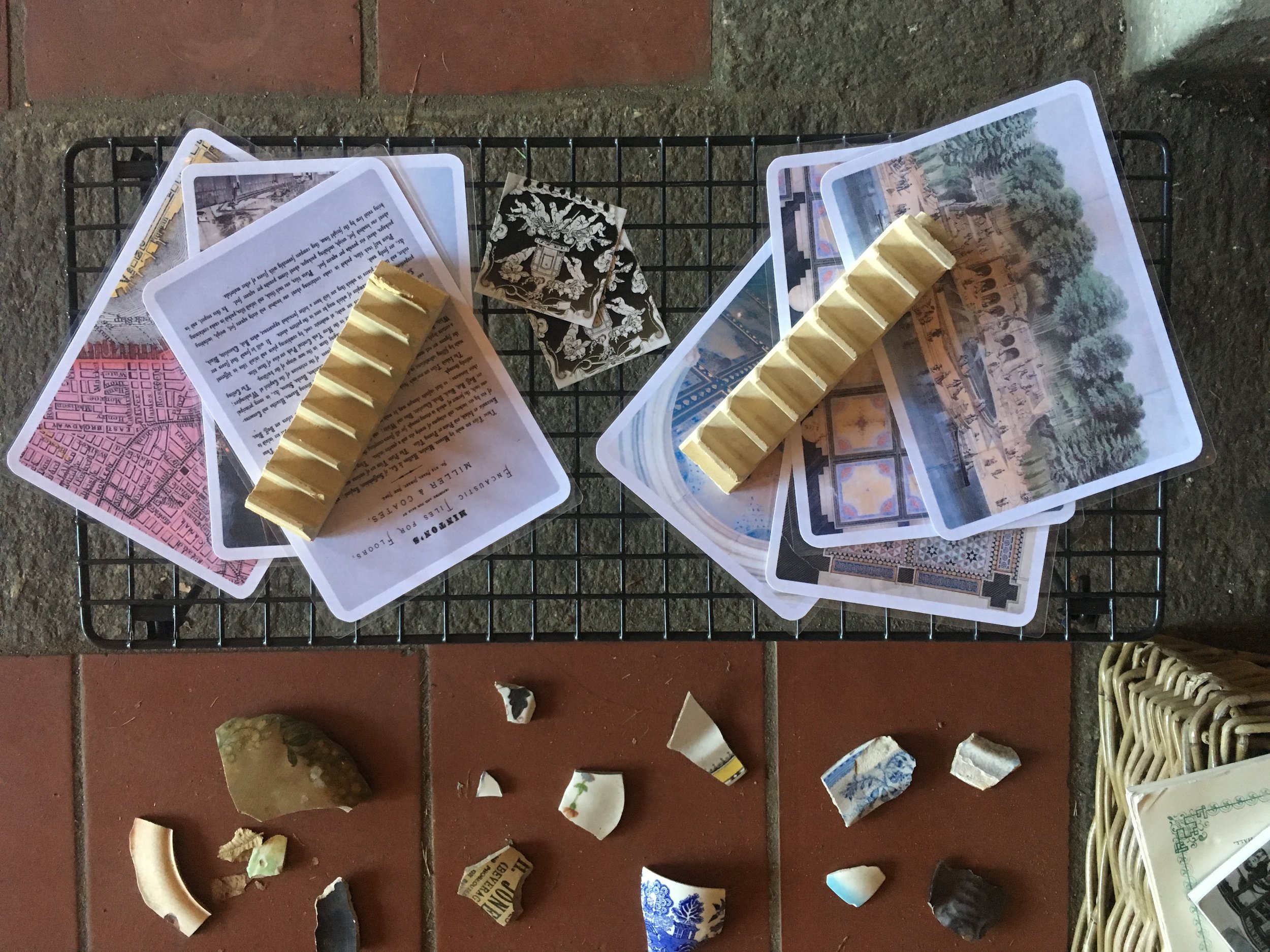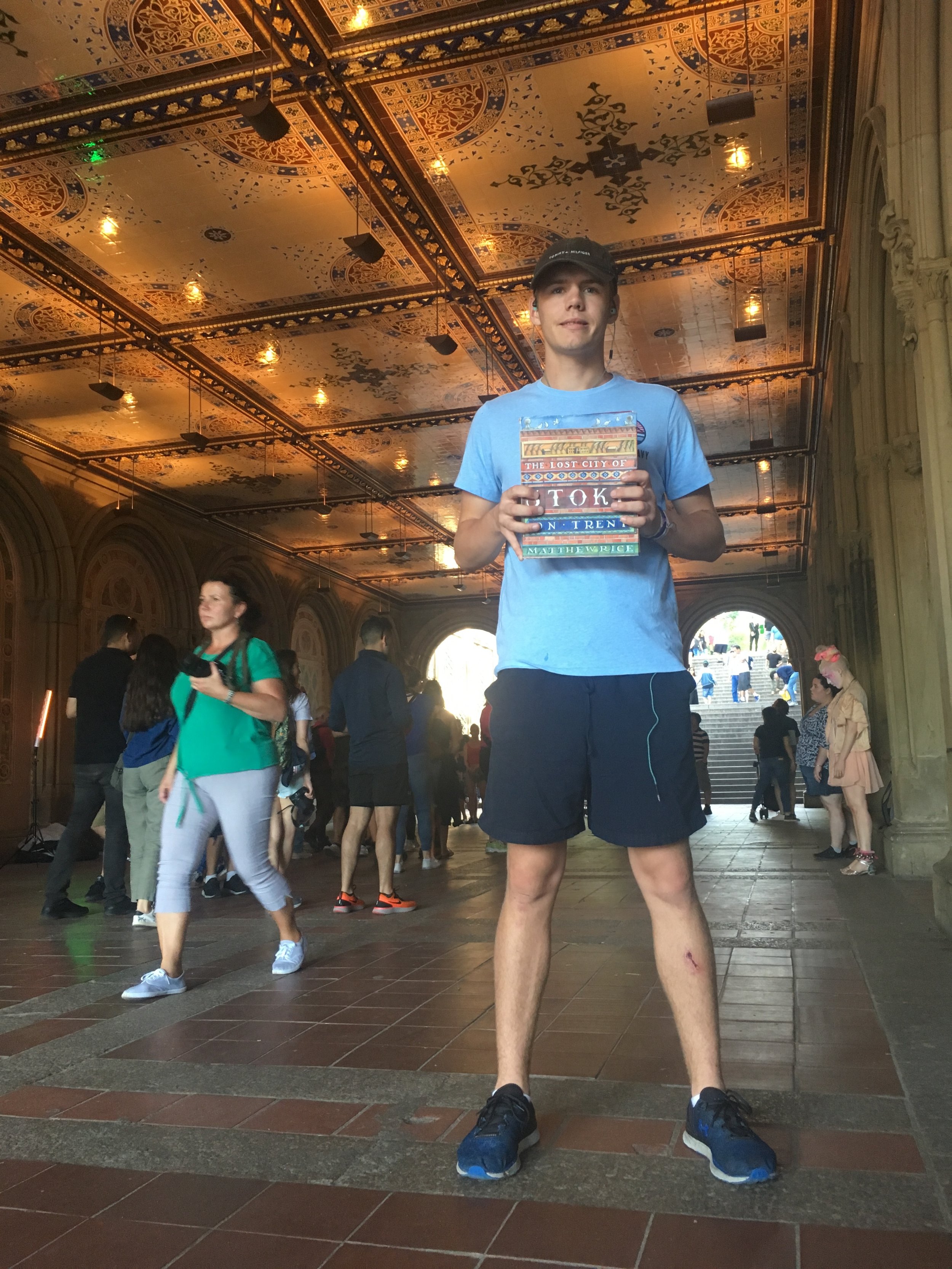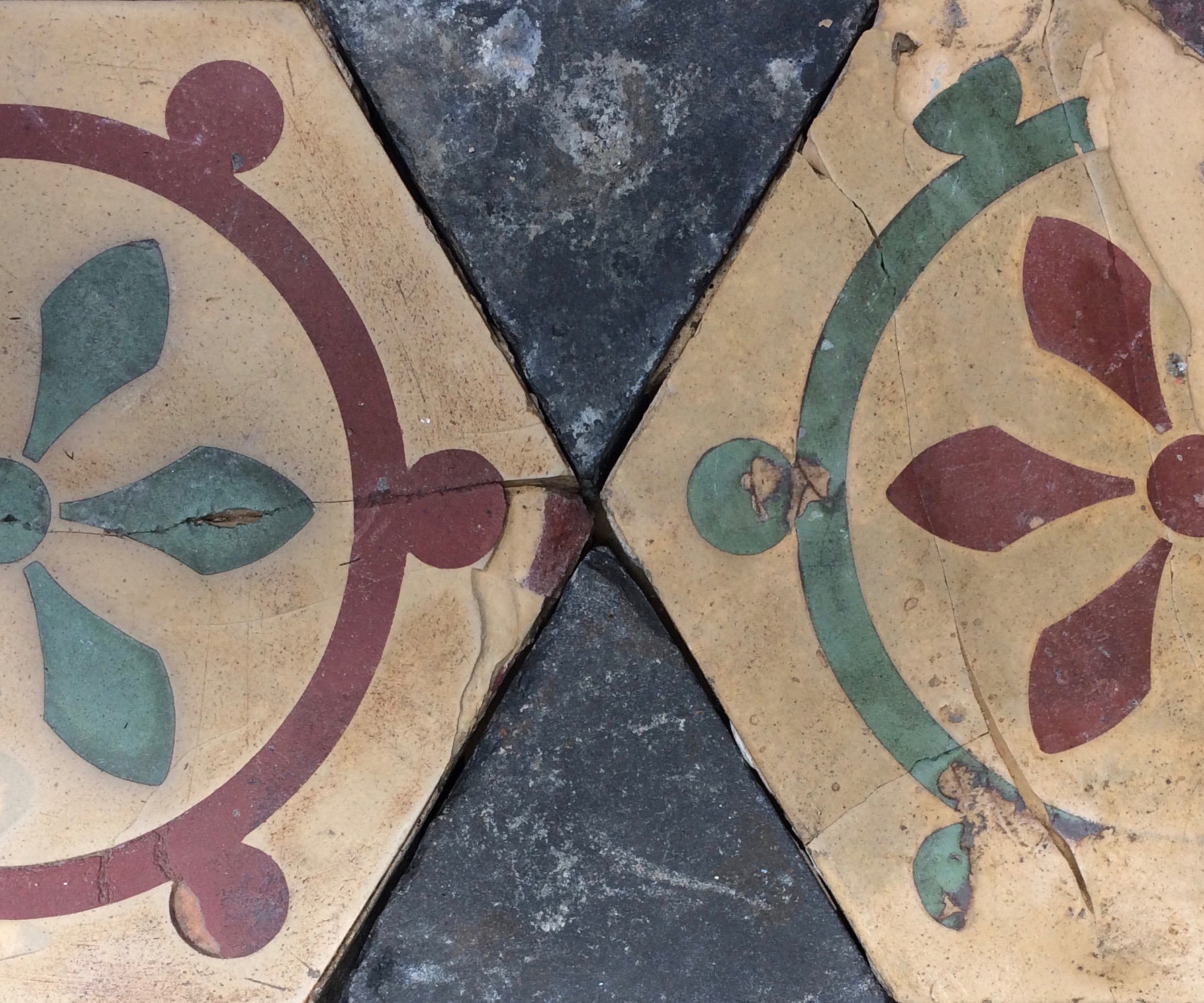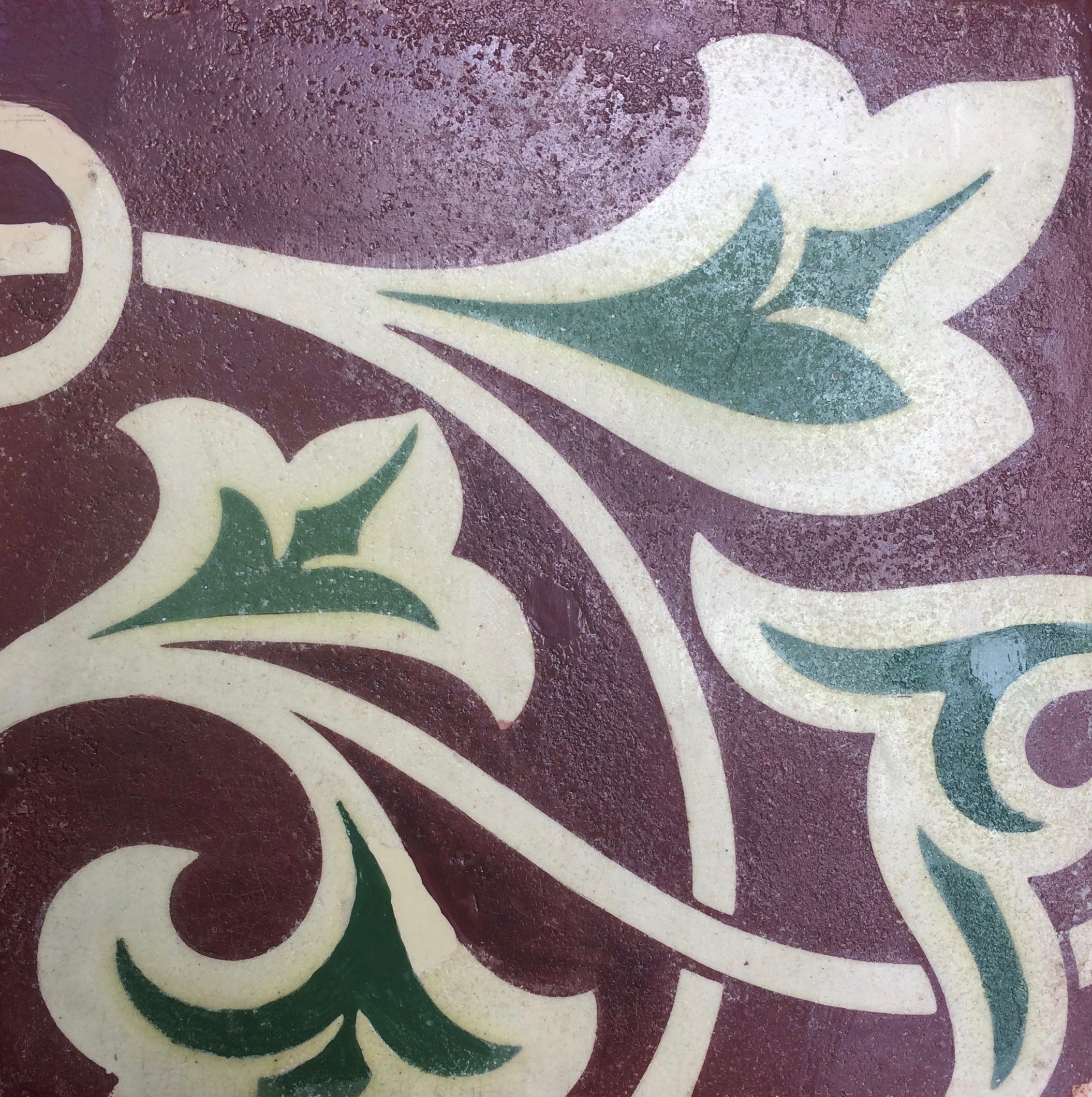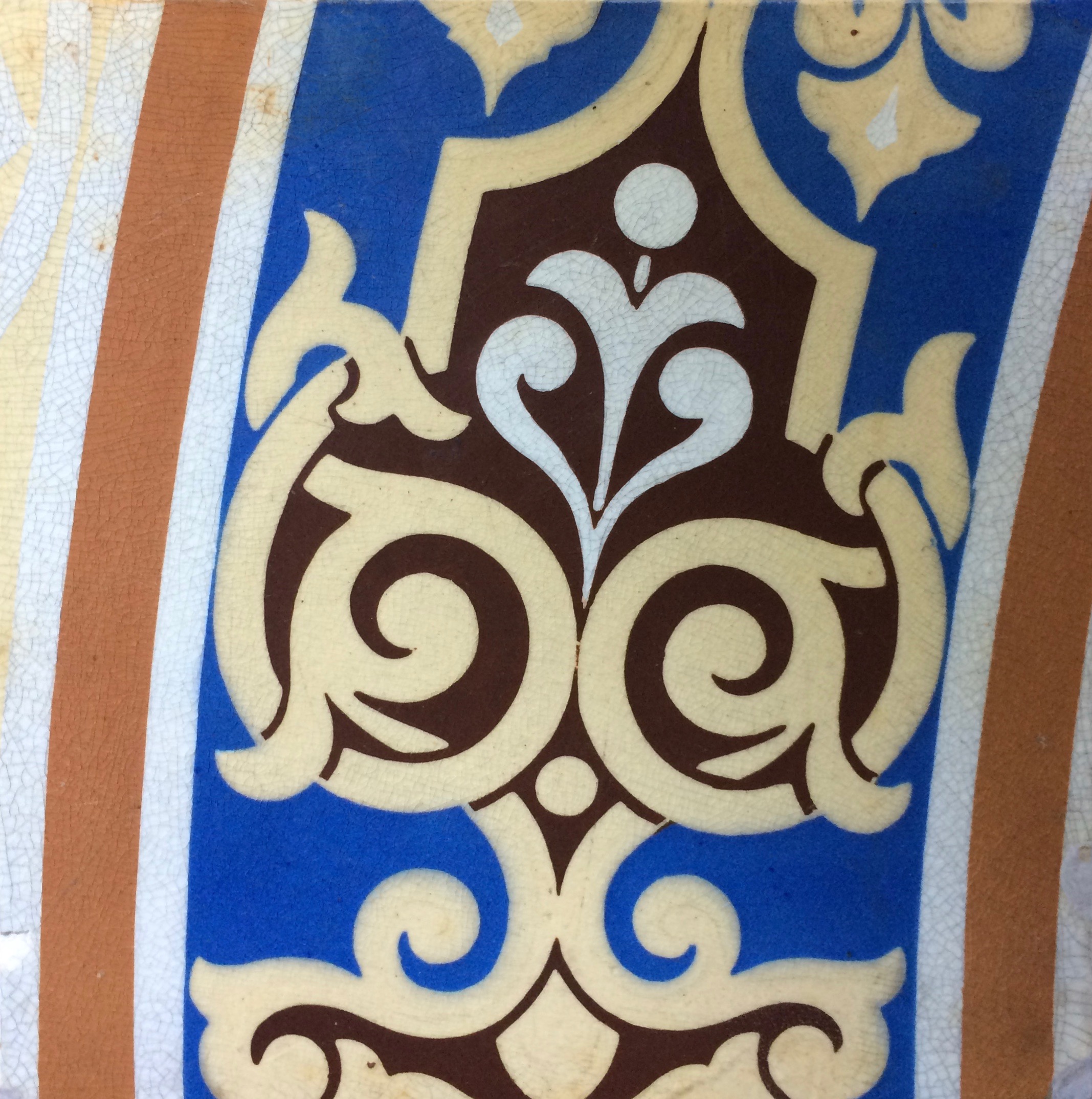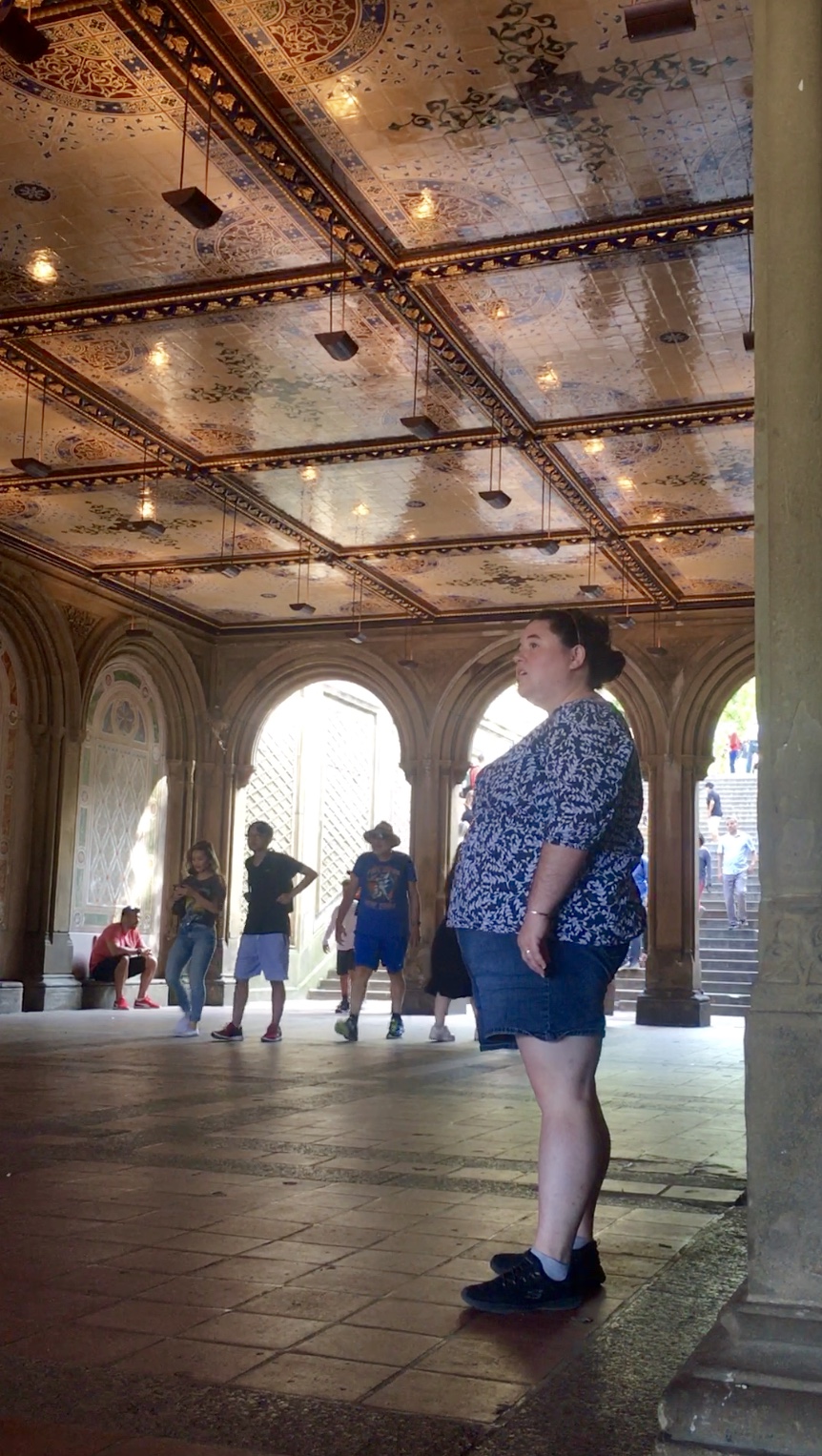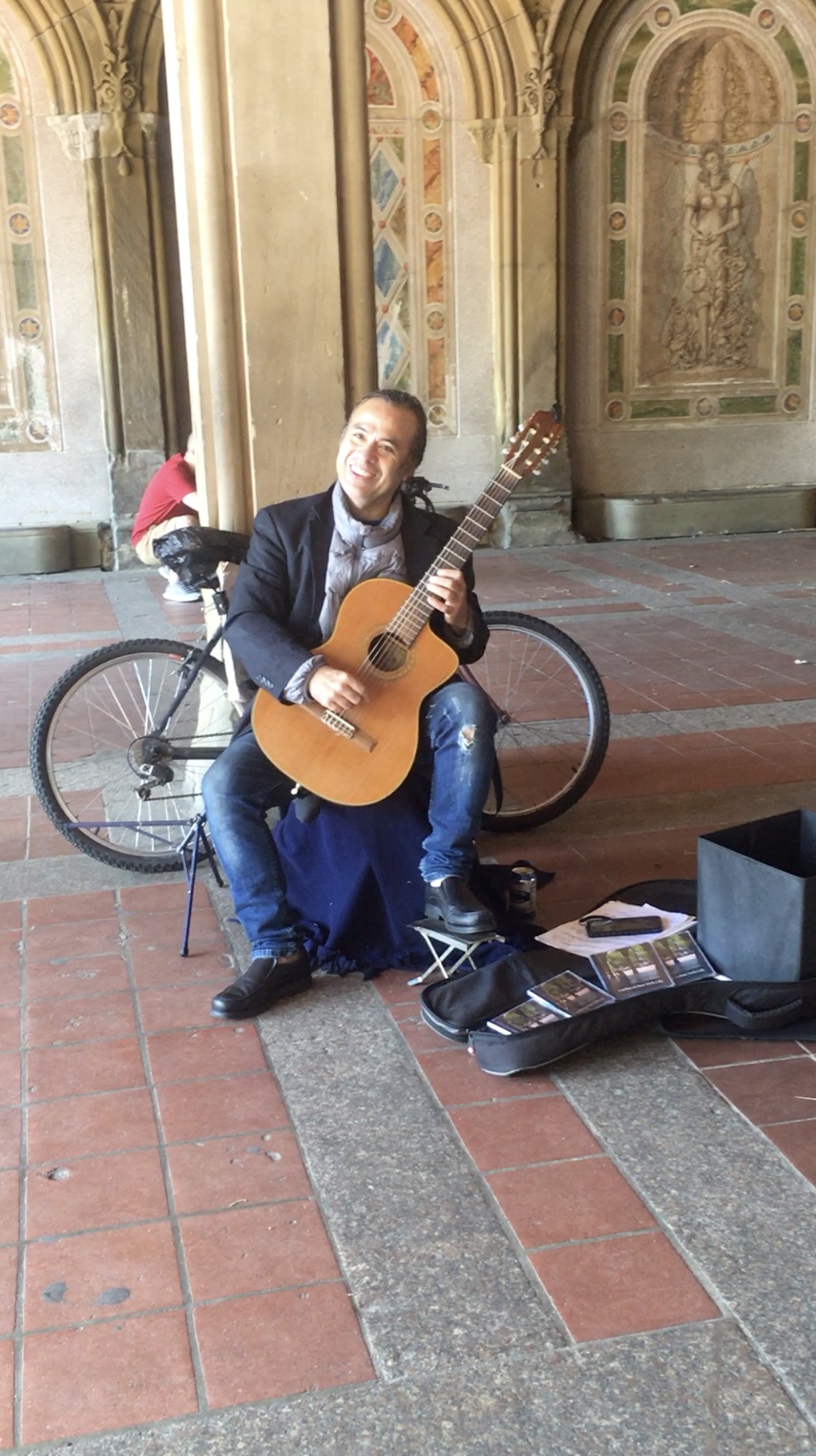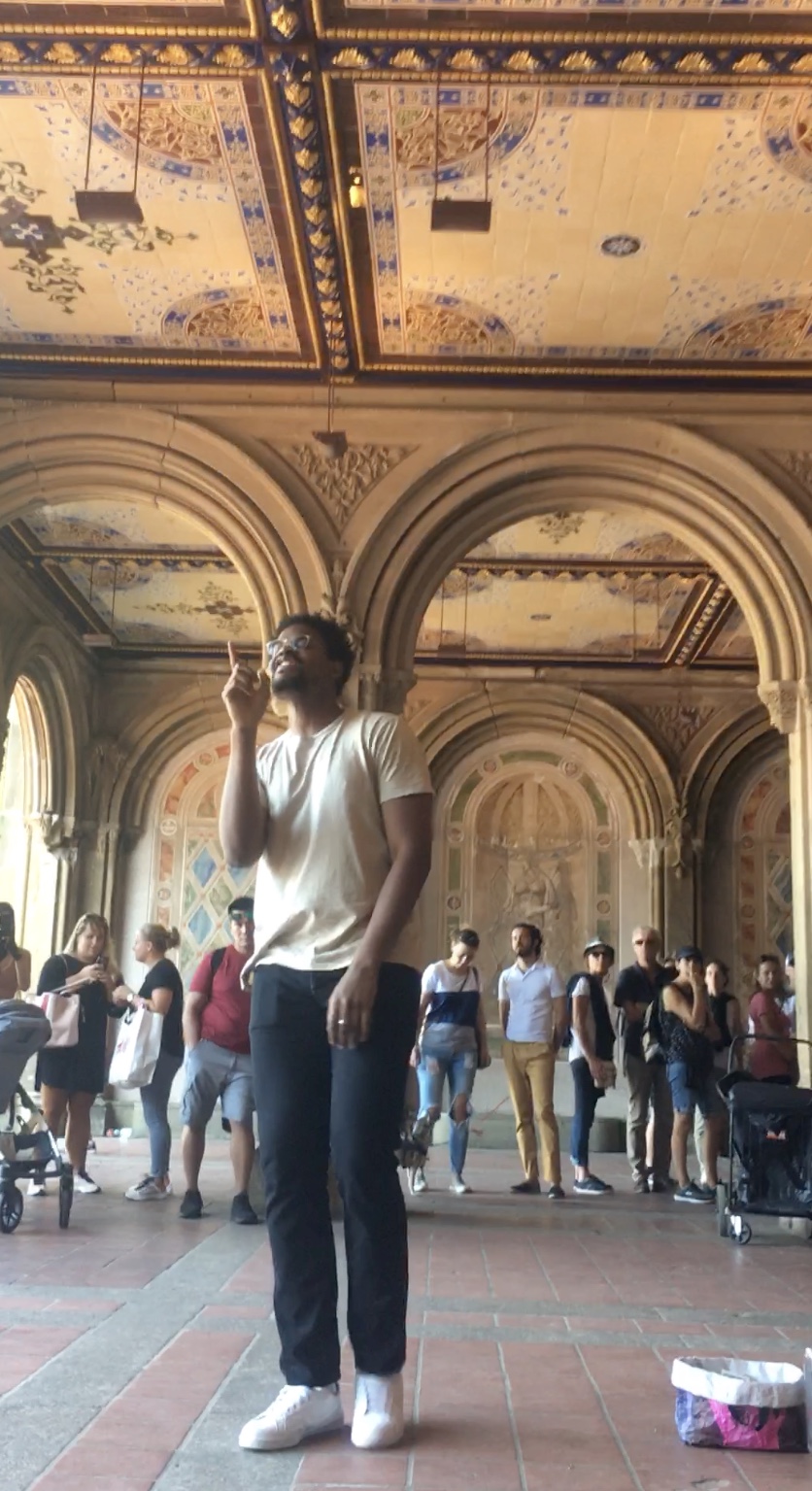Saturday 24th & Sunday 25th AugustPop Up Weekend | Bethesda Terrace Central Park NYCFlushing, Queens:
Early start; our ‘museum-in-a-rucksack’ is actually a fair sized rucksack & a rather large airplane ‘hold bag’ (albeit with wheels & a pull handle). Tiles & tile fragments are a heavy load to lug up & down Subway steps & trundle through undulating grid streets in Upper East Side. A lot of thought & planning went into selecting items to be included. The display needed to be sufficiently unusual, interesting & (hopefully) aesthetically pleasing enough to catch the eye. It must be professional but definitely not slick; this is unashamedly ‘DIY heritage’ it’s about setting your stall out & busking. It also requires a bit of hustle to compete for attention. We eventually decided on a package of interrelated ‘props’ to help explore & piece together the evolving project narrative. It needed ‘quick hits’ as well as depth. The main focus is a selection of original ceiling & floor tiles & tile fragments. The ceiling pieces are remnants of the restoration process & some were used for analysis &/or as test pieces; some are slightly ‘battle worn’ & not the most pristine examples from the collection. Arguably, that means these items are slightly less culturally valuable & less precious from a monetary point of view; although I would argue that they showcase the restoration experiments & process, & that this perhaps adds to their value! In reality, I think the fact that many have ‘test marks’ helped reassure Matt & Central Park Conservancy by taking some of the pressure off issues relating to relative value, security, insurance & ‘custodianship’ for use in the pop up project & subsequent display in Stoke-on-Trent. We also have an original brass dovetail nut & bolt & some original (probably Brooklyn-made) cast iron from the ‘backer plate’. Other pop up museum items included: a laminated set of image cards (kindly produced for us by Andy Perkin), a mini ‘library’ of relevant books & publications, shards found in various locations in North Staffordshire & a selection of geometric tiles (kindly loaned by Simon Ball, Potteries Tiles & Tiling). Finally, we are also using various items of kiln furniture (from our partners The Firing Line) to help display tiles & fragments (& to stop the image cards from blowing away at times!). Will this approach work? I guess we’ll find out over the course of the weekend!
Under the Tiles:
Arrival & set up from around 9am. I was a bit nervous if I’m totally honest. Working on a pop up event at Bethesda Terrace literally under the ceiling is something I’ve wanted to do for more than a decade; I’ve invested a lot of time, energy & money in getting to this point. It’s not that I couldn’t have just turned up ‘unannounced’ from the word go but it’s been important for me to establish links with a community of interest (including Matt/Central Park Conservancy of course along with many others). This has taken a long time & some considerable skill being really honest. These connections don’t come easy; it took me two years to find a way in to the Conservancy (& eventually Matt). That was supported by David Malkin (Malkin Tiles & then H&R Johnson Tiles). I am indebted to David for his support at that time. I also received a research grant & endorsement from TACS (Tiles & Architectural Ceramic Society). That also helped & contributed to me getting a foot in the door of the Conservancy along with David’s endorsement.
So now to the actual set up. I mentioned my reconnaissance mission a few days ago in the previous log post (‘Log: 21.8.19). If you haven’t read the section about how coveted & valuable the space is for street artists then it’s perhaps worth a read to give you sense of why all of this needs such careful consideration. Although I know the Arcade pretty well & have spent quite a lot of time here over the years; the precise location & arrangement for the pop up & display still needed a lot of thought on the day itself on arrival. I have previously studied how people move through the space & how different street artists use different parts of the Arcade for their performances. As also previously explained; It was important that I tried to assimilate with the other artists; taking care not to cause any problems. I think the fact that I wasn’t asking for money from visitors helped ease my way in with some of the performers to be perfectly honest.
So you go up to people, look them in the eye with a smile & say “hello, I’m Danny; how are you…” to which the usual response was “hello; nice to meet you Donny”). After making them laugh by correcting them on my name by explaining it was “Daaaaaa-nny” in a ludicrous New York accent; I would then begin to explain my connection with the tile ceiling; “they were made in my home town; Stoke-on-Trent, England 150 years ago…” That line was enough - it was quite incredible - there was immediate interest & an initial connection; I was ‘in’. The response was different but similar from everyone I met who ‘works’ the Terrace. The performers I spoke with over the weekend all feel strongly about the space & the tiles. Many have good general knowledge & basic facts about the Minton Tile Ceiling (they speak to visitors about the Arcade all the time of course). However, as far as I remember only one artist I met over the two days had actually heard of Stoke-on-Trent & knew about its history of ceramic production (that was Kishan’s friend Peter, a photographer). I’d like to think that’s changed a little bit as a result of our conversations & contribution last weekend.
As it was quite early when I set up on Saturday; there was only one performer in the Arcade. Although I had offered a somewhat tentative nod & smile at Carlos (Konig) when I arrived he was actually in the middle of performing a piece of (beautiful) classical music on his guitar. I decided there & then precisely where felt right to pitch up. I had already more or less made the decision to set up in one of the side areas of the loggia but didn’t want to get lost from view away from the main central footfall. Although some of the artists do use these positions I thought it would be OK to just take up one side leaving the other free. I also took a space one back from the front entrance of the Arcade which left those valuable spaces available for use on both sides if needed. I used the stone plinth seat at the back edge of the arcade behind the display area to store my bags & (deliberately) to sit away from the display at regular intervals. This was to enable people to take an initial look at the items without feeling like they were being ‘hustled’ which is really important. A few people were quite suspicious when I tried to explain that nothing was for sale & it wasn’t about money (due in part to Matt’s involvement as an employee of the Conservancy) I had made a clear decision not to solicit or accept cash donations in the park… just online! ;-) This was interesting in its own right. Visitors were used to being plundered for their money at every turn. A number of people really wanted to give me cash (as a very genuine & generous gesture of thanks & support). One man insisted he give me money for ‘the good work we were doing’. In a small part, this actually reflects the very different approach to culture & ‘giving’ in the USA that I’ve previously experienced. It’s interesting & probably deserves more thinking & perhaps another post at some point. There’s a whole load of fascinating stuff about ‘individual giving’ & taking responsibility for supporting something you value by putting your money where your mouth is as it were. It’s about ‘everyone’ being a benefactor & micro philanthropy; all very interesting especially in relation to notions of ownership & responsibility etc. & worthy of more shared thoughts. However, one final comment; interestingly, all the (most generous) project donations to date have come from Americans or certainly non-UK citizens (as far as we can tell from the online data; although some contributors are anonymous). Back to taking a back seat & leaving people alone in the first instance. It is/was a very conscious approach to best encourage & target people who are more likely to engage in a more detailed conversation. It’s not that the ‘quick hit’ exchanges aren’t important but they do tend to be a bit throw away & result in an understandable ‘well fancy that’. This kind of contact is valuable but there are only so many exchanges of this nature that are practical or useful when balancing the approach with more connected conversations. It’s perhaps worth highlighting again that we probably spoke to approximately 100-150 people each day (250-300 in total) out of an estimated weekend footfall of approximately 5000 visitors who passed through the Arcade. It was inspiring & exhausting in equal measure! One final comment on the ‘set up’. When I was sitting on the side plinth seat later in the weekend; I suddenly realised it was the same plinth I had sat down on & looked up at the tiles from on my first ever visit to the Arcade… definitely meant to be!
The photos below will give you a better idea of the ‘installation’. It is quirky & drew attention from the off; in fact a bit too well! It probably took me most of the rest of the morning to actually get it all out of the boxes & set it all up properly as people wanted to talk & find out more straight away (which was great of course). There’s something fundamentally ‘open’ & intriguing about a work-in-progress in my experience; we experience (& use) a somewhat similar approach at the CLAYHEAD Secret Museum space back in Stoke. Without getting too daft about it; I think it’s about consciously deconstructing the ‘professional construct’ but that’s definitely enough of that for now! Back to the set up. I had ‘practiced’ how it might/was going to look prior to finalising the items & arriving in the United States of course, however, this wasn’t rigid & I wanted to ‘play’ with the various spaces that presented themselves at each location. The current floor at Bethesda Arcade was in place by 1911 (it replaced the original Minton Tile Floor but more about that to come throughout the project!). It’s laid out with (American made) 4” x 4” quarry tiles & granite strips. Interestingly, the general approach retains an overall layout that echoes the original floor design (panels & borders) which also reflects the ceiling panels above. This grid pattern provided a perfect way to frame & organise the tiles & other items. It was exciting to position the floor tile fragments where we know they were laid according to the original Wrey Mould watercolour designs. The tile fragments & original drawing copies on display enabled us to highlight & promote Bethesda Arcade’s important ‘lost floor’. This is a key part of the original commission & transatlantic shared story. It has been lost from view & has been a key focus for my research work & an important driver for the Our Beth project. The lost floor tiles were also made by Minton (Stoke-on-Trent, England) in the mid 1860s. It was exciting to place the floor tiles in their original positions & on public view for the first time since c.1910; that was special.
Matt (& lovely Marcia - thank you for the fab photos!) had arrived as I was beginning to set up. Matt introduced me (properly) to Carlos. We all had a good initial conversation about the tiles & the ‘Our Beth project. Carlos proved to be my connection & ‘way in’ to the community of street artists & other informal custodians of the Arcade & Terrace. He is a lovely man & was very generous throughout the weekend. He introduced me to artists who were performing during the two days & even arranged for a number of other people who weren’t to drop by to speak with me; sincere thanks Carlos! Matt, Marcia & I did get chance to discuss the Terrace, Minton Tiles & the Our Beth project in the morning. We also recorded a short interview to introduce Matt & get his initial take on the project.
There is much more to report about the two days & the many encounters from the Arcade’s amazing community of street artists to the hundreds of conversations with visitors from (literally) across the world. It was an incredibly intense, truly immersive & totally inspiring experience; I will never forget it.
Note: There is another post about some of the performers I met (Heartbeat) & the following podcasts that were recorded under the tiles during the two days (Hello Matt, Thoth & Lila Angelique, Jess Thompson). Have a listen to (hopefully) get a flavour.






